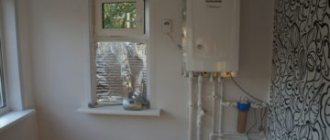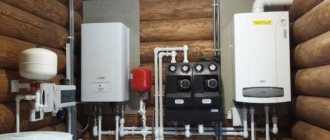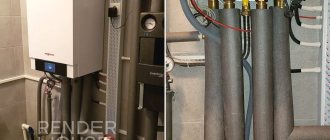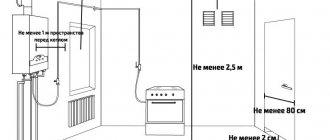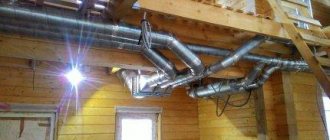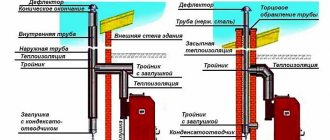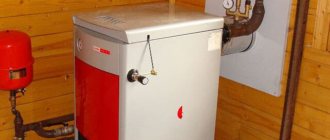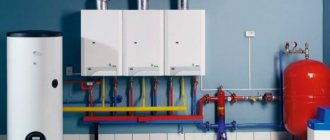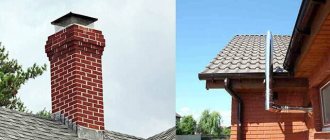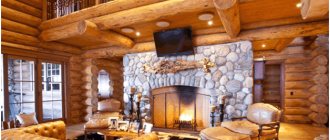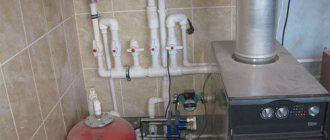Gas is considered the most cost-effective type of fuel in terms of efficiency. Even if there is no gas main line to the holiday village, many owners of country houses use gas tanks, which, from an economic point of view, is often more profitable than using other types of fuel. In any case, you need to know the rules for connecting a gas boiler in a private house, which strictly regulate all the nuances of installation and operation of the equipment.
A modern gas boiler with automation is a rather complex system, the installation and debugging of which requires specialized knowledge Source sovkalmykia.ru
Is it possible to install the equipment yourself?
In short, the installation of a gas boiler in a private house can be carried out by anyone, but commissioning of the equipment - acceptance and testing must be carried out by specialists from the gas service; connecting a gas boiler in a private house and operating it without their permission is impossible.
It is safest to entrust the installation of gas equipment to qualified representatives of a specialized organization. Only they will be able to carry out the necessary work competently, in accordance with the requirements of SNiP, and ensure the safe operation of the equipment. In addition, a competent specialist always works under a contract, which specifies who carried out what work, when and what.
Main types of gas boilers
Manufacturers of gas equipment offer customers different types of heating boilers running on blue fuel. They are designed for heating any area and, according to the type of installation, are divided into floor and wall.
The first of them are powerful, reliable and durable “flagship models”, designed for installation in houses with above-average square footage. There is only one general drawback of such models - they will have to be equipped with a separate room.
Modern floor-standing gas boilers Source vsemixfight.ru
Wall-mounted gas boilers are an excellent alternative for a small private home: they do not require a separate room - such devices are compact and versatile. In addition, their installation does not impose increased conditions on the load-bearing capacity of the wall - it only requires a layer of non-combustible material between the boiler and the base.
Requirements for the boiler room in the house
If the boiler output is more than 30 kW, then it must be installed in a separate room. All information on how to install a gas boiler in a private house is given in the SNiP standards, where there are clear requirements for the arrangement of a boiler room for heating equipment powered by fuel combustion.
You can place the boiler room in the attic, in the basement (basement) or simply in a separate room of the house. A mandatory requirement for this is free passage into the room, sufficient illumination and the arrangement of a rigid base.
In addition, installing a gas boiler in a private house requires the following boiler room:
- volume of at least 13.5 m³ for boilers with a power of 30-60 kW and over 15 m³ for models with higher productivity;
- convenient access to equipment.
Properly designed boiler room for a private home Source teploknam.ru
- within an hour, ventilation should provide three air exchanges;
- walls and ceilings are made of non-combustible material;
Important! Heating boilers are located at a distance of at least 0.5 m from flammable surfaces. And the partitions comply with the fire resistance standard RE1 45, that is, they must resist open fire for 45 minutes.
Types of wall devices
According to their functional purpose, gas heating units are divided into two groups:
- Single-circuit. Intended for heating only. They are connected to the heating circuit and heat the coolant. The organization of hot water supply in this case is carried out by installing an electric or gas water heater of any type.
- Dual-circuit. They heat the room and provide hot water. An additional circuit for heating water is built into the boiler. The technological feature of the device is that it is impossible to simultaneously heat water and heat the room.
The priority action of dual-circuit units is to heat the water; heating operation stops at this time. Considering that water can be heated quickly, the boiler heats the building quite effectively.
If the tasks of the gas unit are planned to include both heating the coolant and supplying hot water, then it is better to purchase a double-circuit boiler. They come with one or two heat exchangers. When equipped with two, two circuits can be served simultaneously
According to the method of fuel combustion, all devices are divided into the following two groups.
Group #1 - devices with an open combustion chamber
Such devices are also called natural draft heating devices. They take the oxygen necessary for combustion from the room in which the device is located.
To remove combustion products, they need a traditional type chimney. Thus, a mandatory requirement for installing such a boiler is the provision of good ventilation.
If the heating device is installed in a residential area, it must be equipped with high-performance supply ventilation.
The best option for installing a heating device with an open firebox is the presence of a separate room, the so-called firebox, where it is placed.
Systems with natural ventilation are quite popular due to their low cost and energy independence.
The figure schematically shows boilers with open and closed type burners
Group #2 - devices with a closed combustion chamber
Turbocharged devices are equipped with a closed combustion chamber. They take the air, without which the combustion process is impossible, from the street. For this purpose, the devices are equipped with coaxial type chimneys.
Such a chimney is made in the form of a structure of two pipes, one of which is nested inside the other. The combustion products are discharged outside through the inner pipe.
At the same time, street air flows in the opposite direction through the gap between the two pipes. It is clear that boilers with a closed firebox do not in any way affect the composition of the indoor air, which makes it possible to install them even in living rooms.
In this case, it is necessary to equip a coaxial chimney system, which is higher cost and more complex installation compared to a separate traditional chimney.
Requirements for a boiler room in a separate building
The advantages of a separate boiler room are increased safety, reduced noise levels and the ability to use the freed up space for other purposes. The disadvantage will be that the heating system will become more expensive, since it will be necessary to install an additional thermally insulated pipeline branch.
At the same time, the requirements for such boiler houses are as follows:
- separate foundation ;
- concrete base for the boiler;
- forced ventilation , which should provide three air exchanges within an hour;
- fulfillment of requirements regarding the size of the boiler room;
- no more than two heating devices can be installed in one room
- doors to the street should open outwards;
SNiP requirements for the external boiler room of a private house Source karelia-dom.ru
See also: Catalog of companies that specialize in insulating country houses.
- wall surfaces and ceilings are made of non-combustible material;
- the presence of a window with a transom for daylight and emergency ventilation - the area of the window opening must be suitable for the volume of the room (0.03 m2 per 1 m³);
- presence of a chimney , if it is needed for the device being installed (for wall-mounted devices with a capacity of less than 30 kW, a coaxial pipe is allowed to exit through the wall).
A sewer pipe is also connected to the boiler so that water can be drained from the system when it is replaced.
Chimney
Particular attention to the correct organization of the chimney
Correct installation of the chimney is no less important than the ventilation system. The chimney can be made of a metal sandwich pipe that is discharged through the roof of the boiler room (or through the wall) and rises along the wall from the outside to the roof.
Convenient and reliable sandwich pipes
Or maybe coaxial, coming out through the wall and having a small size. Each of them is established according to certain rules.
- Combustion products should not enter the room, which means that the smoke exhaust duct must be gas-tight.
- The diameter of the chimney should not be less than the diameter of the pipe leaving the boiler. The ratios for boiler power have been established - the homeowner will definitely be familiarized with these figures when drawing up project documentation.
- The head of the metal pipe must rise above the roof no lower than its ridge - this will ensure normal removal of gas combustion products and prevent backdraft.
- When the chimney is brought out through the wall, a hole is made for it, the pipe is connected to the boiler and taken out into the street. If gaps have formed in the opening between the wall and the chimney, they must be sealed hermetically. This coaxial type flue duct is suitable for a boiler with low or medium power, and is usually used for wall-mounted models.
The head of a coaxial chimney in a wooden house
Basic requirements for smoke exhaust and ventilation ducts
The room where the gas boiler is located must meet the necessary requirements, and not only the width and length of the room is regulated according to the power of the equipment, but also the size to the ceiling, which must be at least 2 m.
A ventilation duct must be installed in the boiler room; for this purpose, a hole with a cross-section of at least 0.02 m2 is provided.
The location of gas boilers corresponds to the installation conditions of the chimney. In this case, the parameters of the latter (height, channel area) in relation to the installed gas equipment must be strictly observed.
Chimneys for a gas boiler in a private house Source pinterest.ru
The size of the internal cross-section of the smoke outlet pipe is made the same or slightly larger than that of the device. According to NPB-98, inside the chimney opening the air flow speed should be 15-20 m/sec, and such draft can be ensured with a chimney pipe height of about 5 meters.
Important! Smoke must not be vented into a duct provided for ventilation. In boiler rooms that have a standard hood, air exchange should take place due to the incoming flow from outside the room and, partially, as a result of its penetration from adjacent rooms.
About the gas duct
The cross-sectional area of the house flue for it depends on the required boiler power (see below). At any power, the diameter of the flue must be at least 110 mm and not less than the diameter of the exhaust pipe. The dependence of the flue diameter on the boiler power is as follows:
- up to 24 kW – 120 mm.
- 30 kW – 130 mm.
- 40 kW – 170 mm.
- 60 kW – 190 mm
- 80 kW – 220 mm.
- 100 kW – 230 mm.
Gas appliance in a private home: requirements and main installation steps
To properly install the unit, you must first study the regulatory documentation and rules for performing this work. They talk about the features of installing gas appliances for the heating system.
Whatever type of boiler would have to be installed, it is imperative to comply with the requirements of certain norms and rules, such as:
- SNiP 41-01-2003 on heating, ventilation and air conditioning.
- SNiP 42-01-2002 on the gas distribution system.
- SNiP 21-01-97 on fire safety.
- SNiP 2.04.08-87 on the installation of boiler houses.
SNiP provisions contain all the necessary information for installing and starting a gas boiler Source optolov.ru
Preparatory work
To install the unit correctly, it is necessary to perform a number of basic works so that no emergency situations arise during operation of the equipment. You need to start by collecting permits. At the same stage, a place for installation of the heating system is selected and prepared. All current regulatory requirements are taken into account.
Preparing all the details
Operating rules
For safe use of gas, the connection diagram for a gas boiler in a private house must be followed. In addition, the following conditions :
- For starting the boiler only at normal humidity.
- Monitoring of technical condition by gas service specialists at least once a year.
- Installing a fine filter on the return pipe of the heating system.
- Natural or artificial ventilation in the boiler room.
- Compliance of draft in the chimney pipe with the requirements (10-20 m/sec).
In the event of a leak, promptly report to the emergency gas service.
Floor-standing
In order to save money, the owners themselves are trying to figure out how to install a floor-standing gas heating boiler in a one-story wooden house. Basic requirements include the following points:
- Strengthening the place where the boiler will be located. It is best to make a screed or carefully lay concrete slabs.
- A gap of at least 15 cm is left between the boiler and the wall surface.
- If the base of the house is not fireproof, then additional cladding with metal sheets is necessary. It is best to insulate the walls with roofing steel, which is laid on an asbestos sheet at least 30 mm wide.
- Using a building level, the condition of the floor is assessed, since the surface under the boiler must be perfectly flat.
- Connecting the chimney is prohibited without first checking the draft.
- Filters are installed that do not trap debris at the entrance to the heat exchanger.
- At the final stage, the prepared double-circuit boiler is connected to the water pipes.
The video provides up-to-date information about installing the boiler:
Maintenance
Preventive measures for routine inspection of gas boilers include the following types of work :
- Checking the valves of the external and internal gas pipelines (disassembling, applying lubricant).
- Inspection of thermostats on floor-standing boilers.
- Washing or replacing filter elements.
- Inspection of nozzles , checking the tightness of the door, the operation of the igniter on floor-standing devices.
- draft control
- ice build-up in winter .
All components that have been subject to wear during operation must be replaced.
On a note! After completion of the repair and before starting the heating system, the gas service worker checks the tightness of all connections in the line. Usually a soap solution is used for this.
A competent preventive inspection will not only increase the service life of the equipment in use, but will also reduce gas consumption.
Repair and maintenance of gas equipment Source sanmaster62.ru
